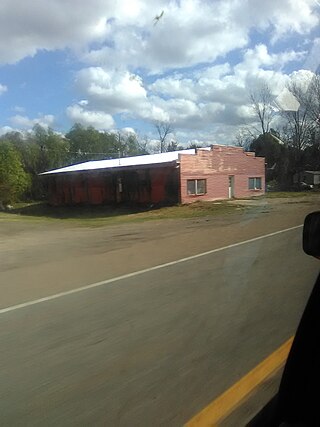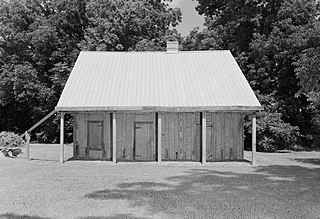
Natchitoches Parish is a parish located in the U.S. state of Louisiana. As of the 2020 census, the population was 37,515. The parish seat and most populous municipality is Natchitoches, the largest by land area is Ashland, and the most densely populated area is Campti. The parish was formed in 1805.

Natchez is a village in Natchitoches Parish, Louisiana, United States. The population was 597 at the 2010 census. It is part of the Natchitoches Micropolitan Statistical Area. The village and parish are part of the Cane River National Heritage Area and located on Isle Brevelle.

The Cane River Creole National Historical Park was established in 1994 to preserve the resources and cultural landscapes of the Cane River region in Natchitoches Parish, Louisiana. Located along Cane River Lake, the park is approximately 63 acres and includes two French Creole cotton plantations, Oakland and Magnolia. Both plantations are complete in their historic settings, including landscapes, outbuildings, structures, furnishings, and artifacts; and they are the most intact French Creole cotton plantations in the United States. In total, 65 historic structures and over a million artifacts enhance the National Park Service mission as it strives to tell the story of the evolution of plantation agriculture through the perspective of the land owners, enslaved workers, overseers, skilled workers, and tenant farmers who resided along the Cane River for over two hundred years. This park is included as a site on the Louisiana African American Heritage Trail.
Plaçage was a recognized extralegal system in French and Spanish slave colonies of North America by which ethnic European men entered into civil unions with non-Europeans of African, Native American and mixed-race descent. The term comes from the French placer meaning "to place with". The women were not legally recognized as wives but were known as placées; their relationships were recognized among the free people of color as mariages de la main gauche or left-handed marriages. They became institutionalized with contracts or negotiations that settled property on the woman and her children and, in some cases, gave them freedom if they were enslaved. The system flourished throughout the French and Spanish colonial periods, reaching its zenith during the latter, between 1769 and 1803.

The Cane River is a 30-mile-long (48 km) river in Natchitoches Parish, Louisiana, originating from a portion of the Red River. In the 19th and 20th centuries, it gained prominence as the locus of a Creole de couleur (multiracial) culture, centered around the Melrose Plantation and the adjacent St. Augustine Parish Church. Melrose Plantation is a National Historic Landmark.

Louisiana Creoles are a Louisiana French ethnic group descended from the inhabitants of colonial Louisiana before it became a part of the United States during the periods of French and Spanish rule. They share cultural ties such as the traditional use of the French, Spanish, and Creole languages and predominant practice of Catholicism.
Marie Thérèse Coincoin, born as Coincoin, also known as Marie Thérèse dite Coincoin, and Marie Thérèse Métoyer, was a planter, slave owner, and businesswoman at the colonial Louisiana outpost of Natchitoches.
The Creoles of color are a historic ethnic group of Louisiana Creoles that developed in the former French and Spanish colonies of Louisiana, Mississippi, Alabama, and Northwestern Florida, in what is now the United States. French colonists in Louisiana first used the term "Creole" to refer to people born in the colony, rather than in Europe, thus drawing a distinction between Old-World Europeans and Africans from their descendants born in the New World. Today, these Creoles of color have assimilated into Black American culture, while some retain their distinct identity as a subset within the broader African American ethnic group.

Oakland Plantation, originally known as the Jean Pierre Emmanuel Prud'homme Plantation, and also known as Bermuda, is a historic plantation in an unincorporated area of Natchitoches Parish, Louisiana. Founded as a forced-labor farm worked by enslaved Black people for White owners, it is one of the nation's best and most intact examples of a French Creole cotton plantation complex. The Oakland Plantation is now owned by the National Park Service as part of the Cane River Creole National Historical Park.

Melrose Plantation, also known as Yucca Plantation, is a National Historic Landmark located in the unincorporated community of Melrose in Natchitoches Parish in north central Louisiana. This is one of the largest plantations in the United States built by and for free people of color. The land was granted to Louis Metoyer, who had the "Big House" built beginning about 1832. He was a son of Marie Thérèse Coincoin, a former slave who became a wealthy businesswoman in the area, and Claude Thomas Pierre Métoyer. The house was completed in 1833 after Louis' death by his son Jean Baptiste Louis Metoyer. The Metoyers were free people of color for four generations before the American Civil War. The Métoyer family was derived from Marie, a former slave, and Claude, a Spanish military gentleman who bought and married Marie. They had many children but they were also one of the largest plantations and owned slaves themselves.

St. Augustine Catholic Church and Cemetery, or the Isle Brevelle Church, is a historic Catholic parish property founded in 1829 near Melrose, Natchitoches Parish, Louisiana. It is the cultural center of the Cane River area's historic French, Spanish, Native American and Black Creole community. It is also the oldest surviving Black Catholic church in the United States.

Cane River is a 2001 family saga by Lalita Tademy. It was chosen as an Oprah's Book Club selection.

The Badin-Roque House is a historic house located along Louisiana Highway 484, about 6.6 miles (10.6 km) southeast of Natchez in the community of Isle Brevelle.
Rosette Rochon (1767–1863) was an American placée and businesswoman, who was an important figure in the Gens de couleur libres society of New Orleans. She belonged to the most famous of the placées of New Orleans alongside Eulalie de Mandéville and Marie Thérèse Metoyer, and made a fortune on investments in dry goods, cattle, banking, slave trade and real estate business.

Isle Brevelle is an ethnically and culturally diverse community, which began as a Native American and Louisiana Creole settlement and is located in Natchitoches Parish, Louisiana. For many years this area was known as Côte Joyeuse. It is considered the birthplace of Creole culture and remains the epicenter of Creole art and literature blending European, African, and Native American cultures. It is home to the Cane River Creole National Historical Park and part of the Louisiana African American Heritage Trail.
Anne des Cadeaux (unknown—1754), was a Native American active in early colonial Louisiana, and was from one of the early Louisiana Creole families. She was a devout Catholic, and was enslaved but later gained her freedom.
St. Anne Chapel at Old River is a historic Catholic chapel founded in the 1800s along the banks of Old River near Cypress and Isle Brevelle in Natchitoches Parish, Louisiana, serving the Old River community. It is the cultural and religious center of the area's Louisiana Creole people, predominantly of French descent.
St. Joseph's Catholic Mission at Bayou Derbonne is a historic Catholic mission founded in the 1800s along the banks of Bayou Derbonne near Montrose and Isle Brevelle in Natchitoches Parish, Louisiana, serving the Montrose and Cloutierville Creole community. It was the cultural and religious center of the area's Louisiana Creole people, predominantly of French descent.
Jean Baptiste Brevelle was a Parisian-born trader, explorer, and one of the first soldiers garrisoned at Fort St. Jean Baptiste des Natchitoches in present-day Natchitoches, Louisiana and Le Poste des Cadodaquious in Texas.
Jean Baptiste Brevelle II was a French and Native American explorer, translator and soldier of the militia at Fort St. Jean Baptiste des Natchitoches in present-day Natchitoches, Louisiana and Le Poste des Cadodaquious in Texas.










